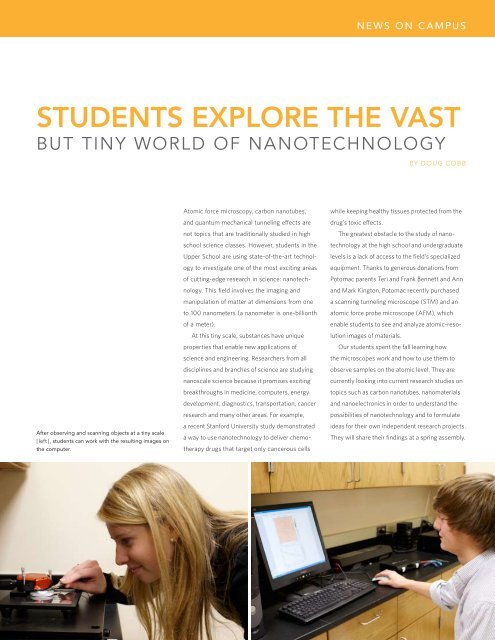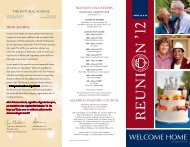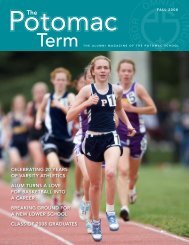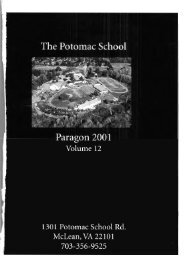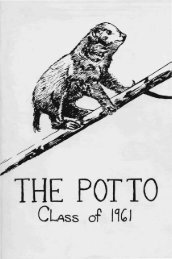Spring 2009 Potomac Term - Potomac School
Spring 2009 Potomac Term - Potomac School
Spring 2009 Potomac Term - Potomac School
Create successful ePaper yourself
Turn your PDF publications into a flip-book with our unique Google optimized e-Paper software.
News On Campus<br />
Students Explore the Vast<br />
But Tiny World of Nanotechnology<br />
By Doug Cobb<br />
After observing and scanning objects at a tiny scale<br />
[ left ], students can work with the resulting images on<br />
the computer.<br />
Atomic force microscopy, carbon nanotubes,<br />
and quantum mechanical tunneling effects are<br />
not topics that are traditionally studied in high<br />
school science classes. However, students in the<br />
Upper <strong>School</strong> are using state-of-the-art technology<br />
to investigate one of the most exciting areas<br />
of cutting-edge research in science: nanotechnology.<br />
This field involves the imaging and<br />
manipulation of matter at dimensions from one<br />
to 100 nanometers (a nanometer is one-billionth<br />
of a meter).<br />
At this tiny scale, substances have unique<br />
properties that enable new applications of<br />
science and engineering. Researchers from all<br />
disciplines and branches of science are studying<br />
nanoscale science because it promises exciting<br />
breakthroughs in medicine, computers, energy<br />
development, diagnostics, transportation, cancer<br />
research and many other areas. For example,<br />
a recent Stanford University study demonstrated<br />
a way to use nanotechnology to deliver chemotherapy<br />
drugs that target only cancerous cells<br />
while keeping healthy tissues protected from the<br />
drug’s toxic effects.<br />
The greatest obstacle to the study of nanotechnology<br />
at the high school and undergraduate<br />
levels is a lack of access to the field’s specialized<br />
equipment. Thanks to generous donations from<br />
<strong>Potomac</strong> parents Teri and Frank Bennett and Ann<br />
and Mark Kington, <strong>Potomac</strong> recently purchased<br />
a scanning tunneling microscope (STM) and an<br />
atomic force probe microscope (AFM), which<br />
enable students to see and analyze atomic-resolution<br />
images of materials.<br />
Our students spent the fall learning how<br />
the microscopes work and how to use them to<br />
observe samples on the atomic level. They are<br />
currently looking into current research studies on<br />
topics such as carbon nanotubes, nanomaterials<br />
and nanoelectronics in order to understand the<br />
possibilities of nanotechnology and to formulate<br />
ideas for their own independent research projects.<br />
They will share their findings at a spring assembly.<br />
<strong>Spring</strong> <strong>2009</strong> 23


